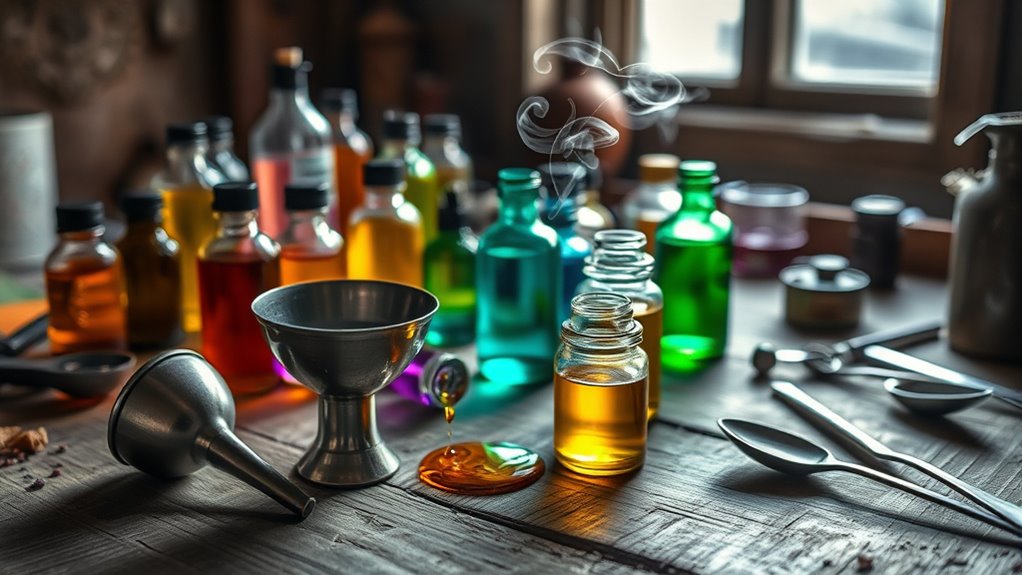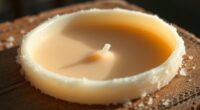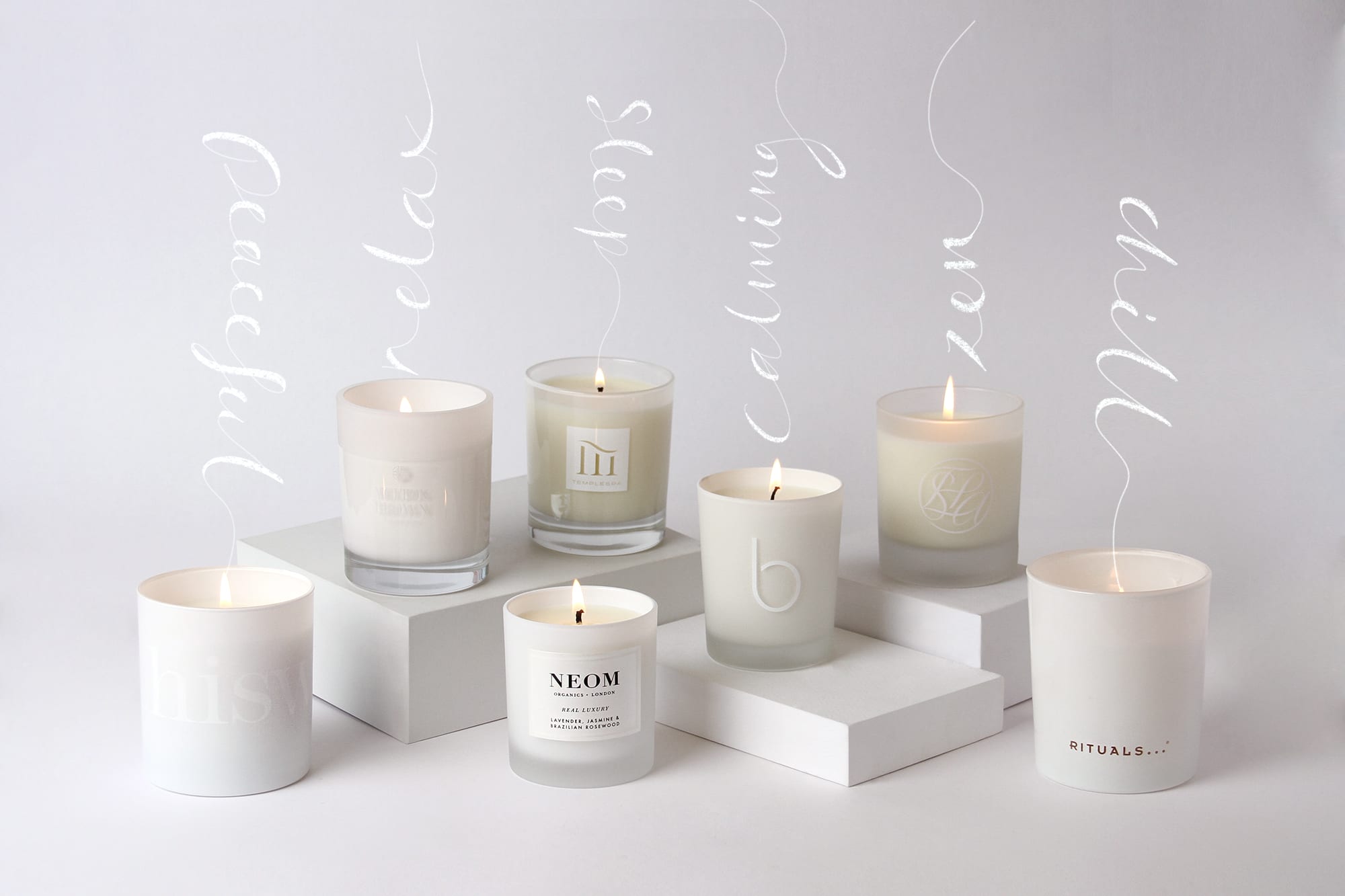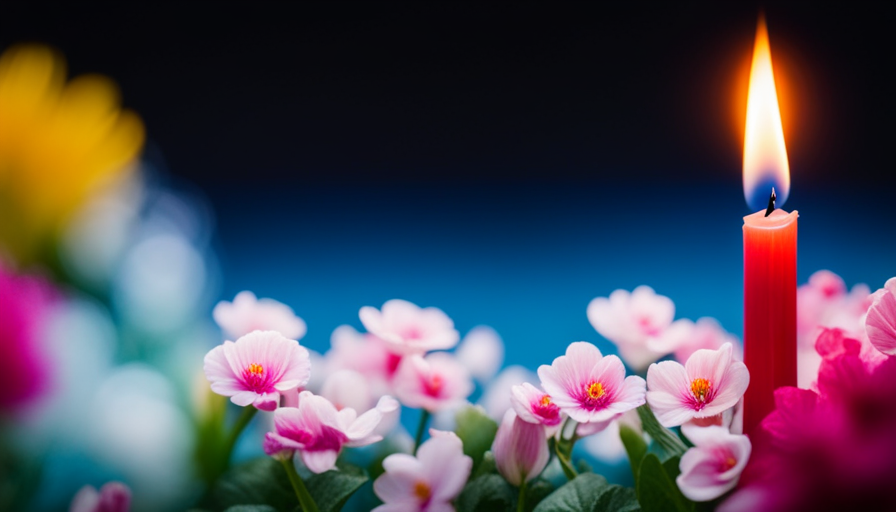As a new chandler, you might struggle with fragrance oils fading over time, blending incompatible scents, or rushing the testing process. Using unstable oils or ignoring proper curing can lead to dull scents and poor customer satisfaction. To dodge these pitfalls, focus on selecting stable, long-lasting oils, blend small batches carefully, and keep detailed notes. Stay tuned to discover more tips that will help you create consistent, professional fragrances that last.
Key Takeaways
- Using untested or unstable fragrance oils can cause scent fading over time.
- Rushing blending without proper testing may result in muddled or overpowering fragrances.
- Not selecting oils formulated for long-term stability leads to dull or inconsistent scents.
- Failing to record ratios and process details hampers replicability and quality control.
- Ignoring scent harmony and balance can produce unappealing or fleeting aromas.

Fragrance oils can add beautiful scents to your home or products, but they also come with potential pitfalls you should be aware of. One of the most common issues new candle makers face is maintaining scent stability. When you’re blending fragrances, it’s easy to assume that all oils will behave the same way, but that’s not the case. Some fragrances fade quickly over time, especially if they’re not formulated for stability. To avoid disappointment, you need to pay attention to how well your scent holds up during the curing process and beyond. This means choosing fragrance oils specifically designed for candle making or other projects where scent longevity matters. Testing your blends by burning a small sample over days or weeks helps you determine whether the scent remains strong and true. Don’t rely solely on the initial aroma; scent stability is key to creating products that customers will love and come back for.
Another critical aspect you should master early on is essential oil blending. Many newcomers underestimate how complex combining different oils can be. Not all essential oils mix well, and improper blending can lead to muddled or overpowering scents. When you’re working with fragrance oils, start small and keep detailed notes of your ratios. Remember that some oils are more volatile or can overpower others, so balancing the intensity is essential. Always consider the top, middle, and base notes when creating a harmonious scent profile. Blending effectively isn’t just about mixing pretty aromas—it’s about understanding how each oil interacts over time and how they influence scent stability. If you rush into blending without testing and adjusting, you risk ending up with a fragrance that doesn’t last or doesn’t smell as intended. Taking your time to refine your scent combinations will result in a more polished, professional product. Additionally, choosing vetted fragrance oils that are designed for stability can significantly improve your results.
In essence, mastering scent stability and essential oil blending sets the foundation for successful fragrance creation. These skills help you craft scents that remain vibrant and true over time, rather than fading or turning dull. If you’re aware of these potential pitfalls from the start, you’ll save yourself frustration and wasted materials. Be patient, test thoroughly, and keep detailed records of your blends. Over time, you’ll develop an intuitive sense of which oils work best together and how to maximize their staying power. Remember, the goal is to create consistent, appealing scents that enhance your products and satisfy your customers. With careful attention to scent stability and thoughtful blending, you can dodge common pitfalls and elevate your craft to a professional level.
Frequently Asked Questions
What Are the Most Common Fragrance Oil Mistakes New Chandlers Overlook?
When selecting fragrance oils, you often overlook essential oil blends and wax compatibility, leading to issues like poor scent throw or uneven burning. You might assume all oils work equally, but incompatible waxes can cause problems. Always test your fragrance oils with different waxes and create essential oil blends carefully. Avoid rushing, and research each scent’s compatibility to make sure your candles burn beautifully and smell wonderful every time.
How Can I Tell if a Fragrance Oil Is High Quality?
To tell if a fragrance oil is high quality, start with fragrance testing—smell it directly from the bottle to assess its potency and clarity. Look for oils with consistent scent profiles and minimal chemical or synthetic notes. Check the oil grading, as higher grades like cosmetic or perfume-grade indicate better quality. Trust reputable suppliers who provide detailed product information, ensuring you’re working with pure, well-crafted fragrance oils for your candles.
Are There Specific Safety Precautions for Handling Fragrance Oils?
When handling fragrance oils, you should always prioritize safety by wearing proper safety gear like gloves and goggles. Make sure to work in a well-ventilated area to avoid inhaling fumes. Store your oils in a cool, dark place, following storage tips to prevent spoilage or accidents. Always read the manufacturer’s guidelines, and handle oils carefully to prevent spills or skin contact. Safety first keeps your crafting enjoyable and risk-free.
What Ingredients Should I Avoid in Fragrance Oils?
Think of fragrance oils like a recipe—you want the best ingredients. Avoid synthetic additives and phthalates, as they can cause allergic reactions or health issues. These ingredients are like weeds in a garden, contaminating your craft. Always check labels and choose oils with natural components. Staying vigilant helps you craft safe, beautiful products that you and your customers will love, without unintended risks.
How Do I Troubleshoot Scent Throw Issues in Candles?
To troubleshoot scent throw issues, start by checking your wick placement; a wick that’s too small or poorly positioned can limit scent dispersal. Also, consider your container size—if it’s too large, the scent may not fill the space evenly. verify your fragrance oils are well blended and the wax is at the right temperature when pouring. Making these adjustments helps improve your candle’s scent throw effectively.
Conclusion
Now that you’ve uncovered these fragrance-oil pitfalls, you’re like a savvy sailor steering clear of rocky shores. With this knowledge as your compass, you can navigate the fragrant seas confidently, avoiding storms and surprises. Each mistake avoided is a star guiding your journey to crafting beautiful, safe candles. So, set sail with confidence, and let your creations shine brighter than a lighthouse on a dark night. Happy chandlering—your fragrant adventure awaits!










